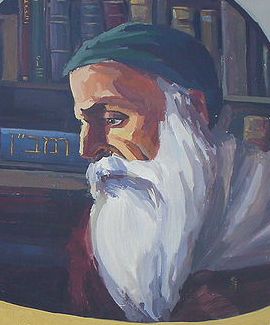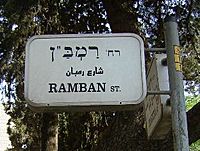Nachmanides facts for kids
Quick facts for kids
Nachmanides
Moses ben Nahman |
|
|---|---|

21st-century artistic depiction
of Nachmanides in Acre, Israel |
|
| Born | 1194 |
| Died | 1270 |
| Era | Medieval philosophy |
| Region | Jewish philosophy |
|
Main interests
|
Religious law |
Moses ben Nachman (1194–1270), often called Nachmanides, was a very important Jewish scholar from the Middle Ages. People also knew him as Ramban. He was a rabbi, philosopher, physician, and a Bible expert. He grew up and lived most of his life in Girona, which is now in Catalonia, Spain. Nachmanides also played a big part in helping the Jewish community return to Jerusalem after it was destroyed by the Crusaders in 1099.
Contents
Who Was Nachmanides?
The name "Nachmanides" comes from Greek and means "son of Nahman". He was also known by the Hebrew nickname Ramban. This is short for "Our Rabbi Moses son of Nahman". His Catalan name was Bonastruc ça Porta, which means "Mazel Tov near the Gate".
Early Life and Education
Nachmanides was born in Girona, Spain, in 1194. He studied there and was sometimes called "Moses son of Nahman the Gironan". He was related to other important Jewish scholars. His teachers taught him about the Talmud, which is a collection of Jewish laws and traditions. He also learned about Kabbalah, which is Jewish mysticism.
Nachmanides also studied medicine. When he was a teenager, he became known as a very smart Jewish scholar. At age 16, he started writing about halakha, which is Jewish law. He showed great respect for older Jewish authorities in his writings. He believed that the wisdom of ancient rabbis should not be questioned.
Nachmanides and Maimonides
Around 1238, Nachmanides was asked to support a scholar named Solomon ben Abraham. Solomon had been banned by people who supported Maimonides, another famous Jewish philosopher. Nachmanides wrote a letter to communities in Spain. In it, he criticized Solomon's opponents.
A Peacemaker
Nachmanides had great respect for Maimonides, even though they had different ideas. He tried to bring peace between the two groups. He wrote to French rabbis, praising Maimonides' good qualities. He said Maimonides' book of Jewish law was very strict, which Nachmanides saw as a good thing.
Nachmanides explained that Maimonides' famous book, Guide for the Perplexed, was not for everyone. It was for people who were confused by non-Jewish ideas from philosophers like Aristotle. Nachmanides suggested that the ban on Maimonides' Jewish law book should be removed. However, he thought the ban on publicly studying the Guide for the Perplexed should stay. This compromise did not work, as both sides rejected it.
Views on Life and Beyond
Nachmanides wrote a book called Torat ha-Adam. This book talks about Jewish customs for mourning and burial. In it, he disagreed with writers who said people should not feel pleasure or pain. He believed that Jewish law tells people to be happy when it's time to celebrate and sad when it's time to mourn.
The Soul and Resurrection
The last part of his book talks about reward, punishment, and life after death. Nachmanides believed that God is fair, so there must be rewards and punishments. These must happen in another world, because good and bad things in this world are temporary.
He taught that humans have a special soul that comes directly from God. This soul existed before the world was created. It enters a person's body and, after death, either returns to God or enters another person's body. He believed that the resurrection mentioned by prophets, which happens after the Messiah comes, refers to the body becoming eternal.
The Barcelona Disputation (1263)
Nachmanides was the chief rabbi of Catalonia. His life changed when he had to defend his faith in a public debate in 1263. This debate was started by a Jewish person who had converted to Christianity, named Pablo Christiani. Pablo wanted Jews to become Christians. He told King James I of Aragon that he could prove Christianity was true using Jewish texts like the Talmud.
Nachmanides agreed to debate, but only if he had complete freedom of speech. For four days, he debated Pablo Christiani in front of the King and many church leaders.
What They Debated
They discussed three main things:
- Had the Messiah already appeared?
- Was the Messiah a divine being or a human?
- Which faith, Jewish or Christian, was the true one?
Pablo Christiani argued that some Jewish texts hinted that the Messiah had already lived and was Jesus. Nachmanides said that Pablo was twisting the meaning of these texts. He pointed out that if Jewish sages believed Jesus was the Messiah, they would have become Christians. He also showed that Jewish beliefs were different from Pablo's ideas.
Nachmanides explained that Jewish prophets saw the future Messiah as a human, not a divine being. He said that the promises of world peace and justice had not yet come true. He noted that since Jesus's time, the world had been full of violence, and Christians were often involved in wars.
He also said that the Messiah was less important to Jewish belief than Christians thought. He argued that it was even more valuable for Jews to follow their laws under a Christian ruler, while suffering, than under the Messiah's rule, when everyone would follow the law easily.
The Outcome
The debate seemed to be going well for Nachmanides. The King was impressed and gave him a gift of 300 gold coins. The King said he had never met someone who argued so well, even if he thought Nachmanides was wrong.
However, the Christian leaders claimed victory. Nachmanides felt he had to publish the debate's text. Pablo Christiani then picked parts from this publication. He said they were insults against Christianity. A serious charge was brought against Nachmanides. The King had to deal with the charge but set up a special group to hear the case.
Nachmanides admitted he had said things against Christianity. But he argued that he had only written what he said during the debate, where the King had given him freedom of speech. The King and the group agreed that his defense was fair. But to please the Christian leaders, Nachmanides was sentenced to leave the country for two years. His book was ordered to be burned. Later, this two-year exile was changed to a permanent banishment.
Life in Jerusalem
Nachmanides left Spain and spent three years in other places. In 1267, he moved to Jerusalem to escape Christian persecution. He built a synagogue in the Old City that still exists today, called the Ramban Synagogue. His work helped restart Jewish community life in Jerusalem. This was important because it marked the beginning of almost 700 continuous years of Jewish life in the city.
Nachmanides then settled in Acre. He worked hard to spread Jewish learning, which was not very common there at the time. Many students came to learn from him, even from far away.
Even though he had friends and students, Nachmanides missed his home. He wrote a letter to his son, describing how empty Jerusalem was. He said there were only two Jewish people living there at the time. In another letter, he told his son to be humble, which he thought was the most important virtue. He also advised his other son, who worked for the King, to pray daily and avoid bad behavior.
Death and Burial
Nachmanides died in the Holy Land when he was over seventy years old. There are different ideas about where he was buried. Some say it was in Haifa, Acre, Hebron, or in the Cave of the Ramban in Jerusalem.
Nachmanides' Writings
Nachmanides wrote many important works. He wrote notes on the entire Talmud. He also created summaries of parts of Jewish law. His main work on the Talmud is called Chiddushei haRamban.
His known works on Jewish law include:
- Mishpetei ha-Cherem, about laws of excommunication.
- Hilkhot Bedikkah, about checking the lungs of animals after slaughter.
- Torat ha-Adam, about mourning and burial customs. The last part of this book talks about life after death.
He also wrote books defending other scholars:
- Milhamot HaShem, defending Isaac Alfasi.
- Sefer ha-Zekhut, also defending Alfasi.
- Hassagot, defending Simeon Kayyara.
Other important works by Nachmanides are:
- A sermon given to the King of Castile.
- Sefer ha-Ge'ulah, about when the Messiah will arrive.
- Iggeret ha-Musar, an ethical letter to his son.
- Iggeret ha-Chemdah, a letter defending Maimonides.
- Vikkuach, the record of his debate with Pablo Christiani.
- Perush Iyyov, a commentary on the Book of Job.
- Bi'ur or Perush 'al ha-Torah, his famous commentary on the Torah.
Some writings that were once thought to be by Nachmanides are now believed to be by other authors. For example, Sodot HaTefilah is by Eleazar of Worms. A collection of responsa (answers to Jewish law questions) is actually by his student, Shlomo ibn Aderet.
| Judah ben Yakar | Natan ben Meir | Azriel of Gerona | |||||||||||||||||||
| Nachmanides | |||||||||||||||||||||
| Shlomo ibn Aderet | |||||||||||||||||||||
Teachers Students
See also
 In Spanish: Nahmánides para niños
In Spanish: Nahmánides para niños
- Girona Synagogue



